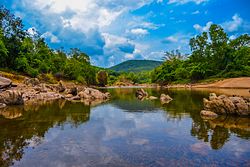| Chandragiri River Perumpuzha / Payaswini | |
|---|---|
 A view of the Chandragiri river from Kanathur, Kasaragod A view of the Chandragiri river from Kanathur, Kasaragod | |
| Etymology | Chandragupta Maurya |
| Location | |
| Country | India |
| State | Kerala, Karnataka |
| District | Kasaragod, Dakshina Kannada, Kodagu |
| Cities | Sullia, Jalsoor, Chengala, Chemnad, Kasaragod |
| Physical characteristics | |
| Source | Kadamakal Reserve Forest, Karnataka |
| • location | Kodagu District, India |
| • coordinates | 12.45495°N, 75.67224°E |
| • elevation | 1290m |
| Mouth | Arabian Sea |
| • location | Near Thalangara, Kasaragod, India |
| • coordinates | 12°28′25″N 74°59′04″E / 12.4737°N 74.9845°E / 12.4737; 74.9845 |
| • elevation | 0 m (0 ft) |
| Length | 105 km (65 mi) |
| Discharge | |
| • location | mouth |
| Basin features | |
| Tributaries | |
| • left | Kudumbur River |
The Chandragiri River, also known as the Payaswini River in Karnataka and as the Perumpuzha River in Kerala, is the longest river in Kasaragod district, Kerala, India. The river is a historical treasure of Chemnad. It was named after the Mauryan emperor Chandragupta Maurya.
The river originates in the Talakaveri Wildlife Sanctuary in the Western Ghats of Kodagu district, Karnataka. It flows through towns including Sullia, Jalsoor, Parappa, Adoor, Chengala, Kasaragod and Chemnad and then later flows into the Arabian Sea. In Sullia taluk, it is the major water source for domestic and agricultural purposes. Chemnad is considered as the Land Of Chandragiri.
History
The Chandragiri or Perumpuzha River is considered the traditional boundary between the Tulu Nadu and Malayalam regions of Kerala.
In 16th-century Portuguese geographies, the Chandragiri River is called the "Rio Cangerecora", and identified as the boundary between the "province of Canará" (Kannada-speaking coastal south Karnataka, vassal of "Bisnaga", Vijayanagara Empire) and the independent kingdoms of "Malabar" (Kerala).
The 17th-century Chandragiri Fort is located on the river.
Course
The Chandragiri River originates from the northern slopes of the Greater Talacauvery National Park in the Western Ghats at the Kodagu district, Karnataka. Initially the river flows through the Malenadu region of Karnataka passing the Pushpagiri Wildlife Sanctuary and flowing through several hilly towns in Kodagu and Dakshina Kannada like Adyadka, Biliyar, Parivarkana, Paladka, Sullia, Pilikodi and Kanyana. Chandragiri then enters Kerala and flows through several hilly towns in the eastern part of the Kasaragod district – Panjikkal, Kottyadi, Adhur, Poovadka, Kottamkuzhy, Bethurpuzha, Kundamkuzhy, Kolathur, Muliyar and Bovikanam. At Bovikanam its major tributary, Kudumbur River merges with Perumpuzha. Then the river enters into the Malabar plains where it flows through Thekkil, Chengala, Chattanchal, Perumbala, Chemnad and Kasaragod. The Chandragiri River empties into the Arabian Sea at Thalangara in Kasaragod town.
Tributaries
The River Chandragiri's largest tributary is the Kudumbur River, which joins the Payaswini on its left bank east of Chattanchal.
See also
References
- "Kasaragod Rivers". www.keralatourism.org. Retrieved 23 January 2021.
- S. Jayashanker (2001). Temples of Kasaragod District. Controller of Publications. p. 4.
- Adoor K. K. Ramachandran Nair (1986). Kerala State Gazetteer. State Editor, Kerala Gazetteers. p. 9.
- "Namboothiri Rulers (Naaduvaazhikal)". www.namboothiri.com. Retrieved 12 July 2021.
- "District Census Handbook - Kodagu District 2011" (PDF). Directorate of Census Operations-Karnataka. 1 October 2011. Retrieved 22 January 2021.
- "District Census Handbook - Dakshina Kannada District 2011" (PDF). Directorate of Census Operations-Karnataka. 1 October 2011. Retrieved 22 January 2021.
- "District Census Handbook - Kasaragod District 2011" (PDF). Directorate of Census Operations-Kerala. 1 October 2011. Retrieved 22 January 2021.
- João de Barros (1552) Decadas da Asia, Dec. I, Bk.9, ch.1, p.296
- Duarte Barbosa (c.1518) Book of Duarte Barbosa, 1918 trans., v.1, p.196
- "Draft Map" (PDF). keralaczma.gov.in. 2012. Archived from the original (PDF) on 28 January 2021. Retrieved 22 January 2021.
| North Malabar Region | |
|---|---|
| Districts | |
| Main Towns and Cities |
|
| Places of interest in North Malabar | |
|---|---|
|
| Capital: Thiruvananthapuram | |||||||
| Districts | |||||||
| Topics | |||||||
| Symbols |
| ||||||
| Taluks |
| ||||||
| Municipal corporations | |||||||
| Municipalities |
| ||||||
| Other towns |
| ||||||
| Historical regions | |||||||
This article related to a location in Kasaragod district, Kerala, India is a stub. You can help Misplaced Pages by expanding it. |
This article related to a river in India is a stub. You can help Misplaced Pages by expanding it. |